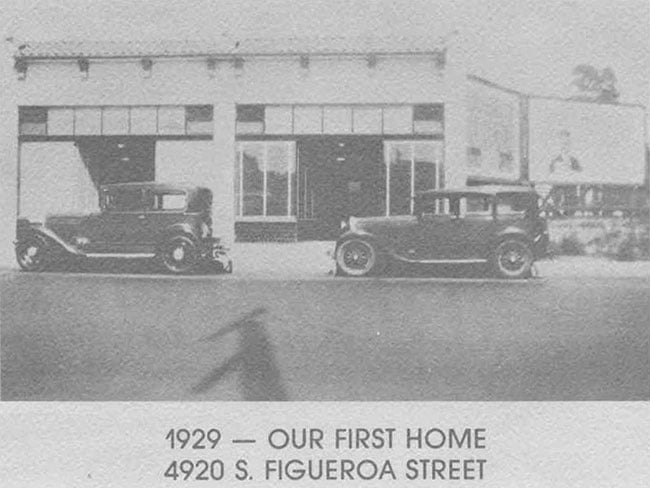A look at almost 95 years of innovation
Our story — the story of Christie — begins, as is only right for a company known for its contributions to the cinema industry, not far from the Hollywood Hills. In California where, in 1929, S.L. Christie started a tradition of technical innovation that still drives us today. But Christie didn't start with cinema, it started with the far-from-glamorous business of battery chargers and power supplies.

But batteries in those days were capricious — and the ability to keep them charged proved to be good business. The new '29 Chevrolet Six may have brought luxury to the masses, but not on damp mornings or in cold weather when the thing wouldn’t start. Christie grew as fast as the Chevy’s batteries failed and S.L. Christie and his partner J.W. McColpin prospered.

Shortly after J.W. McColpin sold his share of the business, S.L. Christie changed the name of the business to Christie Electric Corp. Over the years, Christie acquired optical equipment and transformer businesses. Quietly, a potent mix of optic and electrical expertise started to form.

By the time S.L. Christie’s son Tom took over in 1950 the U.S. economy was booming, and the business expanding. Throughout the 60s and 70s, specialist divisions began manufacturing a range of products, including an increasingly popular range of 35mm film projectors and by the 90s the Electro-Optical division separated to become Christie Inc., and specialized in cinema equipment.

Even in those early days, we understood that what made Christie unique transcended our products. As Tom Christie said on Christie’s 50th anniversary in 1979, “I feel that our most important assets, those assets that truly distinguish Christie from other companies, cannot be pictured in a brochure. For they are the intangibles that have guided us throughout our growth for over 50 years. They are integrity in our business dealings, quality in our products, and service to our customers.”
As our success and growth continued, we became Christie Inc. in the 1990s and shifted our focus solely to cinema equipment, our commitment to integrity, quality, and service remains to this day.

The early years
In entertainment terms, the world Christie had begun building is our world today. A world of universally available and increasingly immersive experiences, where technical advances lead to artistic invention. And cinema was there first, a technology as far-reaching and revolutionary as social media. It was the first globally shared mass entertainment where movie stars were the influencers.
Until the late 1990s, advances in projection technology were almost wholly tied to advances in lamp technology. Film stock might improve, and formats might change, but the light source was always the limiting factor. So, when Christie was purchased by Japanese lamp manufacturer Ushio in 1992, it made perfect sense. We now had a wealth of illumination expertise and technology that ran all the way from Argon to Xenon, combined with a range of projectors that made use of every lumen Ushio could deliver. In 1997, we won our second Technical Achievement Award from the Academy of Motion Picture Arts and Sciences, and then, in 1999, everything changed again.
Digital’s day dawns
Projection had come late to the digital party, but not for want of trying. There had been cathode ray tube-based systems, but these struggled to achieve either the lumens or color gamut of film projection and were universally small-scale. There were exotic systems such as the Eidophor and Talaria that used an electron beam to create images on a spinning, reflective, oil film. But still, nothing that could match intense light through transparent photographic film — a system our founder S.L. Christie would instantly have recognized.
What changed everything was Digital Light Processing. And once again, we were in at the start. It took just one demo to convince our then-chief operating officer Jack Kline that DLP® was not only the future of cinema but of all projection. Christie was the first to license the technology from Texas Instruments® and arranged to acquire Electrohome, a well-known Canadian manufacturer of televisions and projection systems, that had extensive experience in DLP technology. And to make sure there was never any doubt of his plans, Jack added 'digital' to our name. Christie Digital Systems was born.
“Since the technology emerged in the 1960s, ProAV and cinema have enviously eyed laser’s power. This was illumination’s holy grail, but boy, was it tough to tame. But from laser phosphor, through to RGB laser projectors with rack-mounted laser modules, to today’s RGB pure laser powerhouses like the CP4455-RGB and the Griffyn 4K50-RGB, the long-awaited laser age is finally here.”
By March 1999, Christie became the first projection manufacturer to enter the digital cinema market in a meaningful way. After years of frustration and technological dead-ends, digital cinema had arrived, and it wasn't going away.
But cinema isn't just projection. And although we'd helped make digital possible, we knew that wasn't the same as making it a popular, commercial success. Everyone in the business had to buy in big time for that to happen, from studios and movie directors to audiences, distributors, and exhibitors. In short, if it didn't work for everyone, we knew it wouldn't work at all. It’s why one of our proudest achievements wasn't a technical triumph but one that drew on almost 40 years of experience in the cinema business.
It pays to be an industry insider
If you're going to make a big impact, you need big names. Luckily, we knew them all, so when it came to creating a whole new way for the studio system to do business in the shape of a Virtual Print Fee, we could get 20th Century Fox (now 20th Century Studios), Walt Disney Studios, Universal, and Paramount, among others, on-board. Our Christie/AIX initiative introduced thousands of cutting-edge digital cinema projectors from all manufacturers into cinemas and built the reliable commercial model in use today. It supercharged the adoption of digital and transformed how everyone makes, consumes, and funds movies — no wonder we're proud. Once projection was reliably digital and commercially secure, the entire production process could go digital too. And not just in cinemas.
Out in the rental and staging, DOOH (Digital Out-of-Home), and display markets, things were moving just as quickly. Not only did digital projection now mean that if you could digitize it, you could project it, there were new display technologies, too. We were making inroads with LED and Christie MicroTiles® modular rear-projection cubes, which could be tiled to create large display canvases with near-invisible seams. And in 2014, the first of our much-loved Christie Boxer® Series arrived, the Boxer 4K30 3DLP® projector, which at the time was the brightest, lightest, and smartest 30,000 lumen projector around, and the rental-stager's best friend.

A complete solution
And the content those projectors and displays delivered? That was unrecognizable too. In 2015 we acquired coolux and, with it, the Pandoras Box® family of media and show control systems that go a long way to making shows spectacular.
In 2017, we introduced Christie Terra®, the first practical AV-over-IP solution and ProAV's first turnkey SDVoE solution. IT and AV were starting to speak the same language and share the same benefits, a process that doesn't look like it’s slowing any time soon. Then there are our software tools. Christie Conductor monitors and controls up to 256 of our 3DLP projectors, and Christie Twist™ and Christie Mystique™ make image manipulation a breeze, often on the fly, and keep everything rock-solid and in focus when you're finished.
Keeping projectors and displays running issue-free advanced alongside our technology. From its start in the early 2000s with 24/7 remote monitoring, our Professional Services team has grown to include designing, building, deploying, and supporting AV systems, and now, robust tools that manage cinema presentation quality from one centralized platform. Cinergy cloud-based remote monitoring software and management platform tracks assets and consumables, automates key delivery to the screen, and monitors system health in real-time, all while empowering its users and transforming cinema operations.
Like most technology manufacturers with long histories, we’ve evolved from an analog world to a digital future. But we created that future, instead of simply reacting to it – as we did with laser, particularly RGB pure laser.
The power and the purity
Since the technology emerged in the 1960s, ProAV and cinema have enviously eyed laser’s power. This was illumination’s holy grail, but boy, was it tough to tame. But from laser phosphor, through to RGB laser projectors with rack-mounted laser modules, to today’s RGB pure laser powerhouses like the CP4455-RGB and the Griffyn 4K50-RGB, the long-awaited laser age is finally here.
And it's all happened so fast. We premiered Martin Scorsese’s Hugo — the first movie to be publicly shown using laser projection — in 2012. Yet, just 9 years later at Expo 2020 Dubai, no less than 252 of our D4K40-RGB pure laser projectors illuminated the iconic Al Wasl dome. And there’s still plenty of road to go, like our partnership with HuaXia and GDC that’s created CINITY, an advanced LOS that allows 3D in 4K at 120fps. It’s already won global recognition at CineEurope 2022 by winning the Technical Achievement Award.
We’ve screened the premieres at Cannes, equipped the Academy Museum of Motion Pictures in Los Angeles, projection mapped on the world’s tallest statue – the Statue of Unity in India, and lit up the world at countless light shows, film festivals, and art installations. Our customers count on us to work with integrity and pride, to help them deliver projects that inspire and delight guests around the world.
We’ve come a long way, but in approaching our 95th year, Tom Christie’s sentiments from our 50th anniversary still ring true. While we continue to develop innovative technology to meet the needs of our customers today and in the future, our principles remain the same: integrity, quality, and service. That’s the real Christie story right there.
